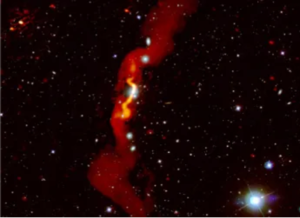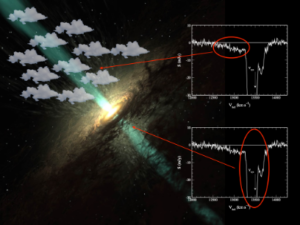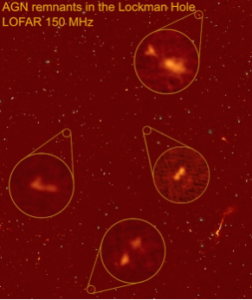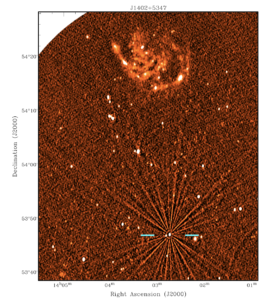ACTIVE GALACTIC NUCLEI
People involved: Raffaella Morganti, Tom Oosterloo, Emanuela Orru, Harish Vedantham
Supermassive black holes (SMBH) are a key ingredient, ubiquitous in the centre of massive galaxies. In their active phase, also known as Active Galactic Nuclei (AGN), they can release huge amount of energy which impact the surrounding medium and the evolution of the host galaxy. One of the manifestations of such energy release is in the form of radio emission and radio plasma jets, which can extend many hundreds of kpc in size.
The work carried out at ASTRON on radio AGN is focused on the understanding of their structure, life-cycle, their impact on the surrounding medium and, consequently, on the evolution of the host galaxy. This is done by using radio facilities, and in particular LOFAR (including I-LOFAR) and Apertif, but also mm radio telescopes (ALMA and NOEMA) as well as optical (like the instruments at the ESO VLT) and X-ray satellites.

COLD GAS AROUND AGN
People involved: Raffaella Morganti
Gas in galaxies can be present if a variety of phases. At ASTRON, we are particularly interested in using radio telescopes to trace cold gas, both atomic neutral hydrogen, observed through the 21 cm line, and molecular gas, thanks to observations of CO transitions.
Signatures of the impact of radio jets can be seen in the disturbed kinematics of the gas. In particular the presence of fast and massive jet-driven gas outflows is indicating that the energy of the AGN can deplete the galaxy of gas. Surprisingly, and despite the extremely energetic phenomena, these outflows can be traced in HI-21 cm absorption and by the molecular components.
We also use the high spatial resolution of the VLBI to determine the precise location of the absorbing gas.

AGN FEEDBACK AND LIFE CYCLES
People involved: Raffaella Morganti, Emanuela Orru
Radio AGN are episodic in nature and the ejections of jets is only a relatively short phase in the lifecycle of a supermassive black hole. Radio jets are believed to last from tens to a few hundreds of millions of years, which represents only a short moment in the life of a galaxy. After this, the supermassive black hole enters a quiet phase. Astronomers think that this cycle can actually repeat multiple times in which the black hole starts a new phase of ejections. The low frequencies and high sensitivity of the LOFAR images are particularly suited for these studies. At ASTRON, we are not only using LOFAR data for identify radio sources in their dying phase, but they also combining the information provided by LOFAR and Apertif in order to quantifying the time radio source spend in each phase.

AGN AT THE HIGHEST ANGULAR RESOLUTION
People involved: John McKean
Understanding the birth and evolution of AGN requires detailed studies of a large sample of radio sources at high angular-resolution. Here, the relativistic plasma that is accelerated close to the central supermassive black hole can be traced through the interstellar medium of the galaxy and out into the intergalactic medium. This allows the full evolutionary path to be observed by studying many objects, which can be used to test models for the triggering of young and restarted radio sources, investigate the relationship between morphology and jet-power, and determine the impact the AGN have on star-formation within their host galaxy. To obtain such detailed imaging for thousands of AGN, we are developing novel wide-field imaging and calibration techniques for very long baseline interferometry, which currently provides the highest angular resolution in astronomy. These data are obtained using the European VLBI Network, which is operated by the JIV-ERIC (based in Dwingeloo).
AGN AS PROBES OF THE INTERSTELLAR MEDIUM
People involved: Harish Vedantham, Tom Oosterloo
Some radio-emitting active galactic nuclei are seen to vary in brightness due to a phenomenon called interstellar scintillation. This is akin to the twinkling of stars due to turbulence in the Earth's atmosphere but the radio twinkling happens due to turbulence in interstellar plasma gas. A very rare from of interstellar scintillation is called "Intra-hour variability" because the brightness variation are unusually rapid, often occurring on timescales of minutes as opposed to the canonical days-long timescale for interstellar scintillation. This rapid variability has been a long-standing mystery because they either imply the presence of unusually dense interstellar gas very close to the Sun for which there is no precedent.
The ongoing survey with the APRTIF feeds on the Westerbork Synthesis Radio Telescope, is a fantastic avenue to find such fast scintillators. As shown in Figure below, the East-West orientation of the array lets to readily identifiable radial spikes emanating from scintillating sources in standard images. At ASTRON, we have exploited this to discover the fastest, and therefore most extreme example of intra-hour variability. We have further discovered over ten such variable sources which provides the necessary sample size to evidence the origin of this mysterious phenomenon.
